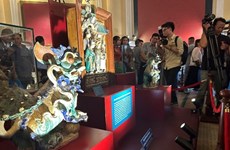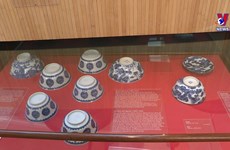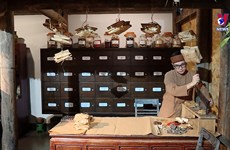Famous sites featured in Vietnamese currency
Vietnamese currency, dong or VND, features special cultural
destinations in the country, namely Hoi An bridge pagoda in central Hoi
An town, Luong Dinh Estrafe and Phu Van La in central Hue imperial city,
Pavallion of the Constellation of Literature in Ha Noi, Ha Long Bay in
northern Quang Ninh province and the childhood house of President Ho Chi
Minh in central Nghe An province
Vietnamese currency, dong or VND, features special cultural
destinations in the country, namely Hoi An bridge pagoda in central Hoi
An town, Luong Dinh Estrafe and Phu Van La in central Hue imperial city,
Pavallion of the Constellation of Literature in Ha Noi, Ha Long Bay in
northern Quang Ninh province and the childhood house of President Ho Chi
Minh in central Nghe An province. Vietnam Government Portal has
introduced about these places as following:
* Hoi An Japanese Bridge (Chua cau) depicted on the 20,000VND note
The bridge ( Chua Cau) is a unique covered structure built by the Japanese in the 17th century. Though called "chua" (place for worshiping the Buddha), the temple has no Buddha statue. The main hall (that called Chua) is reserved for worshiping Bac De Tran Vo – the God protecting the northern region who is believed to bring happiness and wealth to the people in the region.
The Hoi An Japanese bridge is a symbol of the town and beautiful remider of a time long ago.
* Luong Dinh Estrafe, Phu Van Lau featured in the 50,000VND note
Located beside the Perfume River in central Hue imperial city, Nghinh Luong Dinh was served as the place for king and officials to get some fresh air and view. Its view was romantic and ventilated.
Not far from it, Phu Van Lau was built in 1819 under the Gia Long emperor’s reign. It served as the place for putting on royal decrees of the King and court , or the result of the contests organised by the court.
* The Pavillion of Constellation of Literature (Khue Van Cac) captured in the 100,000VND note
Khue Van Cac is in Temple Literature (Van Mieu) on Van Mieu Street, Dong Da District, Hanoi. Although Van Mieu was built long ago, some architectural complexes in this area were erected much later. One of them was Khue Van Cac in 1802, Gia Long took the throne and built the capital in Hue. In 1805, the Commander of the Northern Citadel, Nguyen Van Thanh, ordered the construction of Khue Van Cac at Van Mieu. This project was carried out at the same time as the erection of the surrounding walls around Van Mieu in 1833.
The pavillion was a two0storey complex made of wood and bricks, which is mirrored on the Thien Quang Well.
Van Mieu – Quoc Tu Giam is named a special national vestige site. The main structure is Van Mieu – Temple of Literature – where Khong Tu (Confucius) was worshipped and Quoc Tu Giam – the first university of Vietnam.
* Ha Long Bay depicted in the 200,000VND note
Ha Long bay in northern Quang Ninh province has been recognised as a world natural heritage by UNESCO. Ha Long Bay, in the Gulf of Tonkin, includes some 1,600 islands and islets, forming a spectacular seascape of limestone pillars. Because of their precipitous nature, most of the islands are uninhabited and unaffected by a human presence. The site's outstanding scenic beauty is complemented by its great biological interest.
* Thatched house of President Ho Chi Minh in Sen village printed on the 500,000VND note
Everyone can recognise the simple thatched house where late President Ho Chi Minh spent his entire childhood. The house is in Sen village, Kim Lien ward, Nam Dan district, Nghe An province, in the central region of Vietnam. It is about 15km from Vinh city.
The whole area contains four main important sites : the homeland of President Ho Chi Minh’s mother (Hoang Tru or Chua village), the homeland of President Ho Chi Minh’s father (Sen village), Chung mountain (Kim Lien ward) and the tomb of Hoang Thi Loan (mother of President Ho Chi Minh) in Nam Giang ward.-VNA
* Hoi An Japanese Bridge (Chua cau) depicted on the 20,000VND note
The bridge ( Chua Cau) is a unique covered structure built by the Japanese in the 17th century. Though called "chua" (place for worshiping the Buddha), the temple has no Buddha statue. The main hall (that called Chua) is reserved for worshiping Bac De Tran Vo – the God protecting the northern region who is believed to bring happiness and wealth to the people in the region.
The Hoi An Japanese bridge is a symbol of the town and beautiful remider of a time long ago.
* Luong Dinh Estrafe, Phu Van Lau featured in the 50,000VND note
Located beside the Perfume River in central Hue imperial city, Nghinh Luong Dinh was served as the place for king and officials to get some fresh air and view. Its view was romantic and ventilated.
Not far from it, Phu Van Lau was built in 1819 under the Gia Long emperor’s reign. It served as the place for putting on royal decrees of the King and court , or the result of the contests organised by the court.
* The Pavillion of Constellation of Literature (Khue Van Cac) captured in the 100,000VND note
Khue Van Cac is in Temple Literature (Van Mieu) on Van Mieu Street, Dong Da District, Hanoi. Although Van Mieu was built long ago, some architectural complexes in this area were erected much later. One of them was Khue Van Cac in 1802, Gia Long took the throne and built the capital in Hue. In 1805, the Commander of the Northern Citadel, Nguyen Van Thanh, ordered the construction of Khue Van Cac at Van Mieu. This project was carried out at the same time as the erection of the surrounding walls around Van Mieu in 1833.
The pavillion was a two0storey complex made of wood and bricks, which is mirrored on the Thien Quang Well.
Van Mieu – Quoc Tu Giam is named a special national vestige site. The main structure is Van Mieu – Temple of Literature – where Khong Tu (Confucius) was worshipped and Quoc Tu Giam – the first university of Vietnam.
* Ha Long Bay depicted in the 200,000VND note
Ha Long bay in northern Quang Ninh province has been recognised as a world natural heritage by UNESCO. Ha Long Bay, in the Gulf of Tonkin, includes some 1,600 islands and islets, forming a spectacular seascape of limestone pillars. Because of their precipitous nature, most of the islands are uninhabited and unaffected by a human presence. The site's outstanding scenic beauty is complemented by its great biological interest.
* Thatched house of President Ho Chi Minh in Sen village printed on the 500,000VND note
Everyone can recognise the simple thatched house where late President Ho Chi Minh spent his entire childhood. The house is in Sen village, Kim Lien ward, Nam Dan district, Nghe An province, in the central region of Vietnam. It is about 15km from Vinh city.
The whole area contains four main important sites : the homeland of President Ho Chi Minh’s mother (Hoang Tru or Chua village), the homeland of President Ho Chi Minh’s father (Sen village), Chung mountain (Kim Lien ward) and the tomb of Hoang Thi Loan (mother of President Ho Chi Minh) in Nam Giang ward.-VNA













